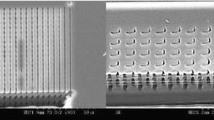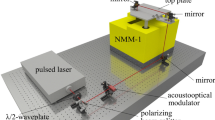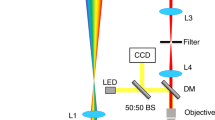Abstract
Direct laser writing (DLW) is a well-known and established technology for fabricating 3D micro- and nanostructures. Usually, red femtosecond laser sources with wavelengths around 800 nm are used. Here, we use a laser diode with a wavelength of 405 nm as the exciting laser source and thus improve structures in terms of decreasing feature size and line distance by exploiting the linear wavelength dependence of the Sparrow resolution limit. A nonlinear multi-photon polymerization process is necessary for manufacturing true 3D structures. We investigate different photoresists and measure their nonlinearities by variation of the electronic pulse scheme of the laser. We observe an adequately high nonlinearity in a resist system based on the monomer pentaerythritol triacrylate. To benefit from the improved theoretical resolution of the smaller wavelength, it is necessary to achieve a close to diffraction-limited focal spot which we have confirmed by measuring the point spread function of the objective lens and comparing it to numerical simulations. In order to prove the performance of the system, we fabricate benchmark structures and characterize them with different experimental methods. Line gratings and point arrays are written to investigate 2D resolution and feature sizes. To characterize the capabilities in 3D, we fabricate woodpile photonic crystals that show a photonic stop band in the visible. The achievable lattice constants in both 2D and 3D are considerably smaller than in previous work with red femtosecond lasers, proving the success of the wavelength-reduction approach. Previous work using the conceptually diffraction-unlimited STED technology is also outperformed.
You have full access to this open access chapter, Download conference paper PDF
Similar content being viewed by others
Keywords
These keywords were added by machine and not by the authors. This process is experimental and the keywords may be updated as the learning algorithm improves.
FormalPara AbstractDirect laser writing (DLW) is a well-known and established technology for fabricating 3D micro- and nanostructures. Usually, red femtosecond laser sources with wavelengths around 800 nm are used. Here, we use a laser diode with a wavelength of 405 nm as the exciting laser source and thus improve structures in terms of decreasing feature size and line distance by exploiting the linear wavelength dependence of the Sparrow resolution limit. A nonlinear multi-photon polymerization process is necessary for manufacturing true 3D structures. We investigate different photoresists and measure their nonlinearities by variation of the electronic pulse scheme of the laser. We observe an adequately high nonlinearity in a resist system based on the monomer pentaerythritol triacrylate. To benefit from the improved theoretical resolution of the smaller wavelength, it is necessary to achieve a close to diffraction-limited focal spot which we have confirmed by measuring the point spread function of the objective lens and comparing it to numerical simulations. In order to prove the performance of the system, we fabricate benchmark structures and characterize them with different experimental methods. Line gratings and point arrays are written to investigate 2D resolution and feature sizes. To characterize the capabilities in 3D, we fabricate woodpile photonic crystals that show a photonic stop band in the visible. The achievable lattice constants in both 2D and 3D are considerably smaller than in previous work with red femtosecond lasers, proving the success of the wavelength-reduction approach. Previous work using the conceptually diffraction-unlimited STED technology is also outperformed.
Author information
Authors and Affiliations
Corresponding author
Editor information
Editors and Affiliations
Rights and permissions
Copyright information
© 2017 Springer Science+Business Media Dordrecht
About this paper
Cite this paper
Mueller, P., Thiel, M., Wegener, M. (2017). Direct Laser Writing of 3D Nanostructures Using a 405nm Laser Diode. In: Di Bartolo, B., Collins, J., Silvestri, L. (eds) Nano-Optics: Principles Enabling Basic Research and Applications. NATO Science for Peace and Security Series B: Physics and Biophysics. Springer, Dordrecht. https://doi.org/10.1007/978-94-024-0850-8_38
Download citation
DOI: https://doi.org/10.1007/978-94-024-0850-8_38
Published:
Publisher Name: Springer, Dordrecht
Print ISBN: 978-94-024-0848-5
Online ISBN: 978-94-024-0850-8
eBook Packages: Physics and AstronomyPhysics and Astronomy (R0)




